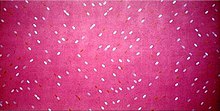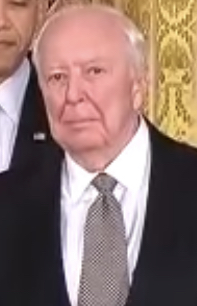
Jasper Johns is an American painter, sculptor, draftsman, and printmaker. Considered a central figure in the development of American postwar art, he has been variously associated with abstract expressionism, Neo-Dada, and pop art movements.
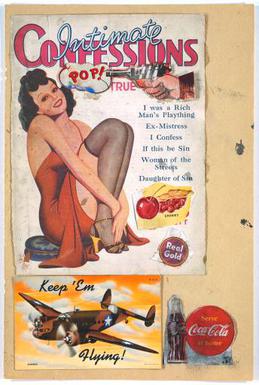
Pop art is an art movement that emerged in the United Kingdom and the United States during the mid- to late-1950s. The movement presented a challenge to traditions of fine art by including imagery from popular and mass culture, such as advertising, comic books and mundane mass-produced objects. One of its aims is to use images of popular culture in art, emphasizing the banal or kitschy elements of any culture, most often through the use of irony. It is also associated with the artists' use of mechanical means of reproduction or rendering techniques. In pop art, material is sometimes visually removed from its known context, isolated, or combined with unrelated material.

Hard-edge painting is painting in which abrupt transitions are found between color areas. Color areas often consist of one unvarying color. The Hard-edge painting style is related to Geometric abstraction, Op Art, Post-painterly Abstraction, and Color Field painting.

Color field painting is a style of abstract painting that emerged in New York City during the 1940s and 1950s. It was inspired by European modernism and closely related to abstract expressionism, while many of its notable early proponents were among the pioneering abstract expressionists. Color field is characterized primarily by large fields of flat, solid color spread across or stained into the canvas creating areas of unbroken surface and a flat picture plane. The movement places less emphasis on gesture, brushstrokes and action in favor of an overall consistency of form and process. In color field painting "color is freed from objective context and becomes the subject in itself."

Leo Castelli was an Italian-American art dealer who originated the contemporary art gallery system. His gallery showcased contemporary art for five decades. Among the movements which Castelli showed were Surrealism, Abstract Expressionism, Neo-Dada, Pop Art, Op Art, Color field painting, Hard-edge painting, Lyrical Abstraction, Minimal Art, Conceptual Art, and Neo-expressionism.
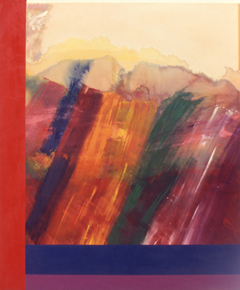
Ronnie Landfield is an American abstract painter. During his early career from the mid-1960s through the 1970s his paintings were associated with Lyrical Abstraction, and he was represented by the David Whitney Gallery and the André Emmerich Gallery.
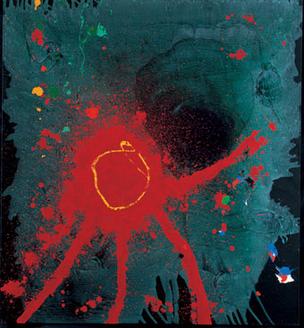
Lyrical abstraction is either of two related but distinct trends in Post-war Modernist painting:
Friedel Dzubas was a German-born American abstract painter.

Ronald "Ron" Davis is an American painter whose work is associated with geometric abstraction, abstract illusionism, lyrical abstraction, hard-edge painting, shaped canvas painting, color field painting, and 3D computer graphics. He is a veteran of nearly seventy solo exhibitions and hundreds of group exhibitions.
Walter Darby Bannard was an American abstract painter and professor of art and art history at the University of Miami.
Dan Christensen, was an American abstract painter He is best known for paintings that relate to Lyrical Abstraction, Color field painting, and Abstract expressionism.
Peter Ford Young is an American painter. He is primarily known for his abstract paintings that have been widely exhibited in the United States and in Europe since the 1960s. His work is associated with Minimal Art, Post-minimalism, and Lyrical Abstraction. Young has participated in more than a hundred group exhibitions and he has had more than forty solo exhibitions in important contemporary art galleries throughout his career. He currently lives in Bisbee, Arizona.

Claes Oldenburg was a Swedish-born American sculptor best known for his public art installations, typically featuring large replicas of everyday objects. Another theme in his work is soft sculpture versions of everyday objects. Many of his works were made in collaboration with his wife, Coosje van Bruggen, who died in 2009; they had been married for 32 years. Oldenburg lived and worked in New York City.

20th-century Western painting begins with the heritage of late-19th-century painters Vincent van Gogh, Paul Cézanne, Paul Gauguin, Georges Seurat, Henri de Toulouse-Lautrec, and others who were essential for the development of modern art. At the beginning of the 20th century, Henri Matisse and several other young artists including the pre-cubist Georges Braque, André Derain, Raoul Dufy and Maurice de Vlaminck, revolutionized the Paris art world with "wild", multi-colored, expressive landscapes and figure paintings that the critics called Fauvism. Matisse's second version of The Dance signified a key point in his career and in the development of modern painting. It reflected Matisse's incipient fascination with primitive art: the intense warm color of the figures against the cool blue-green background and the rhythmical succession of the dancing nudes convey the feelings of emotional liberation and hedonism.

Minimalism describes movements in various forms of art and design, especially Visual art and music, where the work is set out to expose the essence, essentials or identity of a subject through eliminating all non-essential forms, features or concepts. As a specific movement in the arts it is identified with developments in post–World War II Western Art, most strongly with American visual arts in the 1960s and early 1970s. Minimalism is often interpreted as a reaction to abstract expressionism and a bridge to postminimal art practices. Prominent artists associated with this movement include Ad Reinhardt, Nassos Daphnis, Tony Smith, Donald Judd, John McCracken, Agnes Martin, Dan Flavin, Robert Morris, Larry Bell, Anne Truitt, Yves Klein and Frank Stella. Artists themselves have sometimes reacted against the label due to the negative implication of the work being simplistic.
The Druds was a short-lived 1963 avant-garde noise music band founded by Andy Warhol, that featured prominent members of the New York proto-conceptual art and minimal art community. The band's noise rock sound has been compared to that of Henry Flynt and/or The Primitives, the band that featured the first collaboration of Lou Reed and John Cale, who would soon form The Velvet Underground.
Robert Scull was an American art collector, best known for his "world-famous collection of Pop and Minimal art". Born in New York to Russian immigrant parents, Scull dropped out of high school and had various jobs until his wife inherited a share of a taxi business. When this thrived, the couple started buying abstract art and later pop art.

Joanna Pousette-Dart is an American abstract artist, based in New York City. She is best known for her distinctive shaped-canvas paintings, which typically consist of two or three stacked, curved-edge planes whose arrangements—from slightly precarious to nested—convey a sense of momentary balance with the potential to rock, tilt or slip. She overlays the planes with meandering, variable arabesque lines that delineate interior shapes and contours, often echoing the curves of the supports. Her work draws on diverse inspirations, including the landscapes of the American Southwest, Islamic, Mozarabic and Catalan art, Chinese landscape painting and calligraphy, and Mayan art, as well as early and mid-20th-century modernism. Critic John Yau writes that her shaped canvasses explore "the meeting place between abstraction and landscape, quietly expanding on the work of predecessors", through a combination of personal geometry and linear structure that creates "a sense of constant and latent movement."
David Ross Novros, is an American artist. He is known for his minimalist geometric paintings, shaped canvases, and his use of color. He has also studied fresco painting extensively.
The Tanglewood Press was a fine print publisher established by Rosa Esman in 1964. It was known for specializing in producing portfolio editions.
